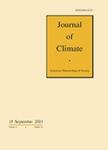版权所有:内蒙古大学图书馆 技术提供:维普资讯• 智图
内蒙古自治区呼和浩特市赛罕区大学西街235号 邮编: 010021

作者机构:Natl Ctr Atmospher Res Climate & Global Dynam Div POB 3000 Boulder CO 80307 USA Univ Colorado Boulder Cooperat Inst Res Environm Sci Boulder CO USA NOAA Earth Syst Res Lab Boulder CO USA
出 版 物:《JOURNAL OF CLIMATE》 (气候杂志)
年 卷 期:2016年第29卷第19期
页 面:6841-6859页
核心收录:
学科分类:07[理学] 070601[理学-气象学] 0706[理学-大气科学]
基 金:Office of Polar Programs at the National Science Foundation Directorate For Geosciences Office of Polar Programs (OPP) Funding Source: National Science Foundation
主 题:Circulation/ Dynamics Atmosphere-ocean interaction Atmospheric circulation Feedback Large-scale motions Teleconnections Models and modeling Climate models
摘 要:The purpose of this study is to elucidate the individual and combined roles of thermodynamic and dynamic ocean-atmosphere coupling in the equilibrium global climate response to projected Arctic sea ice loss using a suite of experiments conducted with Community Climate System Model, version 4, at 18 latitude-longitude spatial resolution. The results highlight the contrasting spatial structures and partially compensating effects of thermodynamic and dynamic coupling. In combination, thermodynamic and dynamic coupling produce a response pattern that is largely symmetric about the equator, whereas thermodynamic coupling alone yields an antisymmetric response. The latter is characterized by an interhemispheric sea surface temperature (SST) gradient, with maximum warming at high northern latitudes decreasing toward the equator, which displaces the intertropical convergence zone (ITCZ) and Hadley circulation northward. In contrast, the fully coupled response shows enhanced warming at high latitudes of both hemispheres and along the equator;the equatorial warming is driven by anomalous ocean heat transport convergence and is accompanied by a narrow equatorward intensification of the northern and southern branches of the ITCZ. In both cases, the tropical precipitation response to Arctic sea ice loss feeds back onto the atmospheric circulation at midlatitudes via Rossby wave dynamics, highlighting the global interconnectivity of the coupled climate system. This study demonstrates the importance of ocean dynamics in mediating the equilibrium global climate response to Arctic sea ice loss.